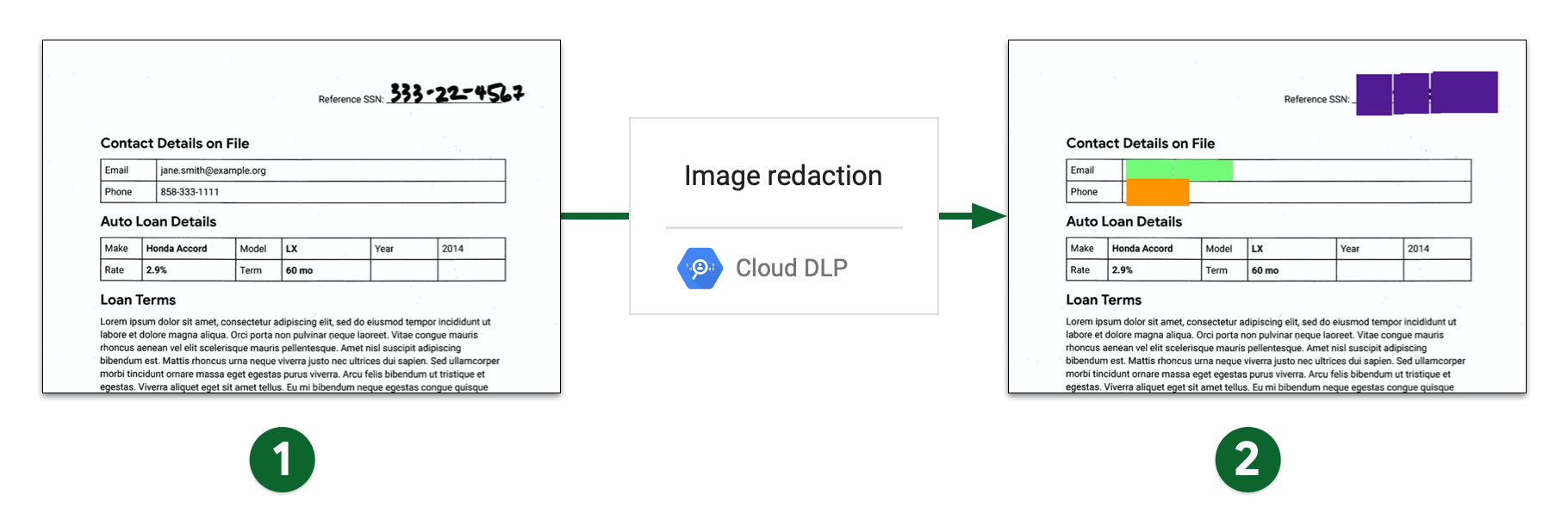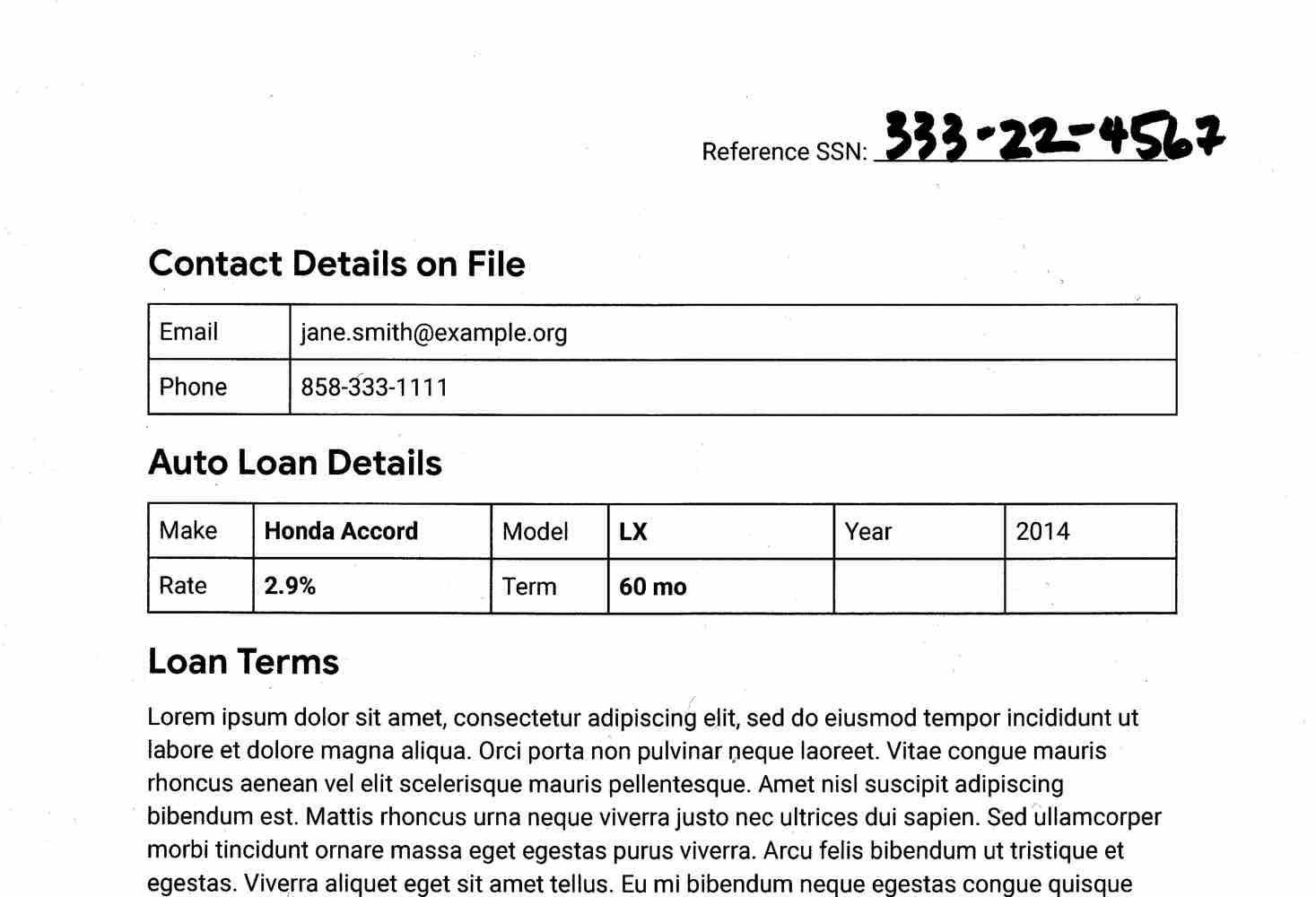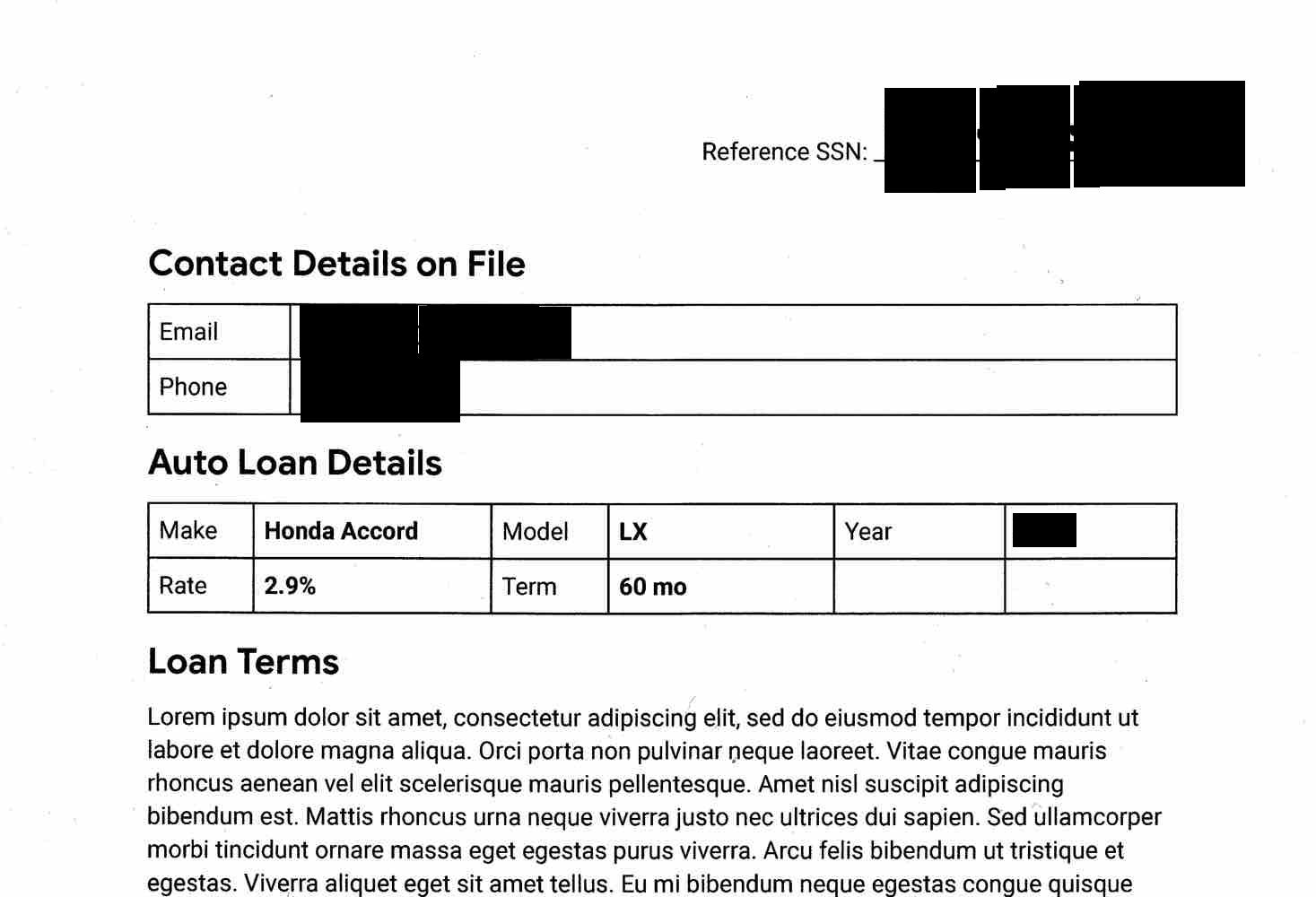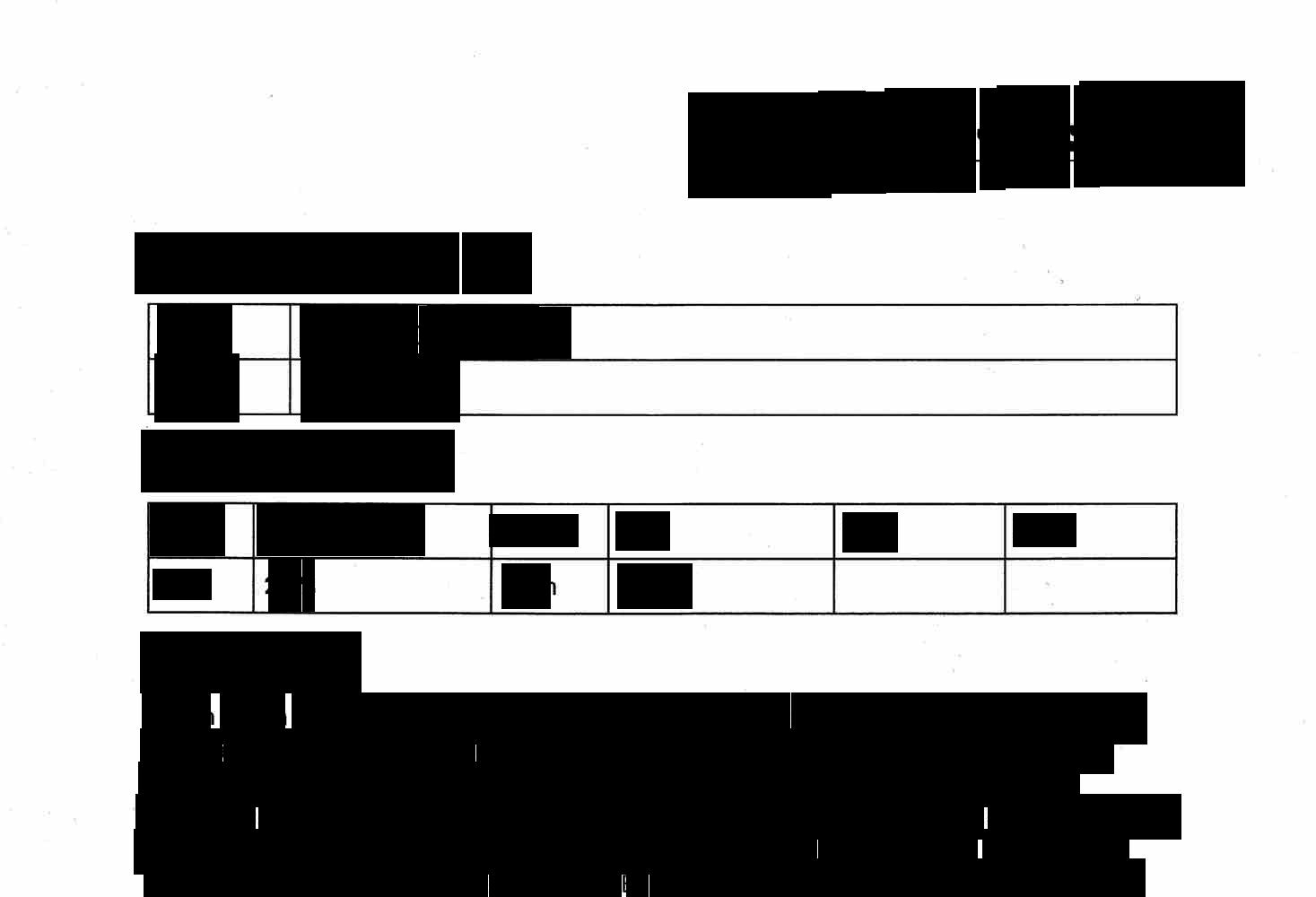La protección de datos sensibles puede ocultar el texto sensible de una imagen. Con los detectores de Infotipos y Cloud Vision, la protección de datos sensibles inspecciona una imagen en busca de texto, detecta datos sensibles dentro del texto y, luego, muestra una imagen con los datos sensibles coincidentes ocultos por un rectángulo opaco.
Por ejemplo, considera las siguientes imágenes de antes y después del ocultamiento. La imagen original es un ejemplo de un archivo de imagen común generado a partir del escaneo de un documento en papel. En este ejemplo, la Protección de datos sensibles se configuró para ocultar números de seguridad social, direcciones de correo electrónico y números de teléfono de EE.UU. con rectángulos de diferentes colores, según el contenido.

- Imagen escaneada antes del ocultamiento
- Imagen escaneada después del ocultamiento
Limitaciones y consideraciones
Ten en cuenta los siguientes puntos cuando ocultes contenido de las imágenes.
Tipos de archivos admitidos
La Protección de datos sensibles puede ocultar los datos sensibles de muchos tipos de imágenes, como JPEG, BMP y PNG. Para obtener más información, consulta Tipos de archivos admitidos.
Los archivos SVG, PDF, XLSX, PPTX y DOCX no admiten la ocultación de contenido.
Límites de resultados
Cuando se ocultan los datos de las imágenes, no se aplican los límites de búsqueda. Pueden causar resultados inesperados o potencialmente incoherentes, en los que solo se ocultan algunos datos. Si incluyes FindingLimits en tu solicitud, la protección de datos sensibles generará un error.
Antes de comenzar
- Accede a tu cuenta de Google Cloud. Si eres nuevo en Google Cloud, crea una cuenta para evaluar el rendimiento de nuestros productos en situaciones reales. Los clientes nuevos también obtienen $300 en créditos gratuitos para ejecutar, probar y, además, implementar cargas de trabajo.
-
En la página del selector de proyectos de la consola de Google Cloud, selecciona o crea un proyecto de Google Cloud.
-
Asegúrate de que la facturación esté habilitada para tu proyecto de Google Cloud.
-
Habilita la API de DLP.
-
Crear una cuenta de servicio:
-
En la consola de Google Cloud, ve a la página Crear cuenta de servicio.
Ve a Crear cuenta de servicio - Elige tu proyecto.
-
Ingresa un nombre en el campo Nombre de cuenta de servicio. La consola de Google Cloud completa el campo ID de cuenta de servicio en función de este nombre.
Opcional: en el campo Descripción de la cuenta de servicio, ingresa una descripción. Por ejemplo,
Service account for quickstart. - Haz clic en Crear y continuar.
-
Otorga el rol Project > Owner a la cuenta de servicio.
Para otorgar el rol, busca la lista Seleccionar un rol y, luego, selecciona Project > Owner.
- Haga clic en Continuar.
-
Haz clic en Listo para terminar de crear la cuenta de servicio.
No cierres la ventana del navegador. La usarás en la próxima tarea.
-
-
Haz lo siguiente para crear una clave de cuenta de servicio:
- En la consola de Google Cloud, haz clic en la dirección de correo electrónico de la cuenta de servicio que creaste.
- Haga clic en Claves.
- Haz clic en Agregar clave y, luego, en Crear clave nueva.
- Haga clic en Crear. Se descargará un archivo de claves JSON en tu computadora.
- Haga clic en Cerrar.
-
Configura la variable de entorno
GOOGLE_APPLICATION_CREDENTIALSen la ruta del archivo JSON que contiene tus credenciales. Esta variable solo se aplica a la sesión actual de Cloud Shell. Por lo tanto, si abres una sesión nueva, deberás volver a configurar la variable. - Instala Google Cloud CLI.
-
Para inicializar la CLI de gcloud, ejecuta el siguiente comando:
gcloud init
-
En la página del selector de proyectos de la consola de Google Cloud, selecciona o crea un proyecto de Google Cloud.
-
Asegúrate de que la facturación esté habilitada para tu proyecto de Google Cloud.
-
Habilita la API de DLP.
-
Crear una cuenta de servicio:
-
En la consola de Google Cloud, ve a la página Crear cuenta de servicio.
Ve a Crear cuenta de servicio - Elige tu proyecto.
-
Ingresa un nombre en el campo Nombre de cuenta de servicio. La consola de Google Cloud completa el campo ID de cuenta de servicio en función de este nombre.
Opcional: en el campo Descripción de la cuenta de servicio, ingresa una descripción. Por ejemplo,
Service account for quickstart. - Haz clic en Crear y continuar.
-
Otorga el rol Project > Owner a la cuenta de servicio.
Para otorgar el rol, busca la lista Seleccionar un rol y, luego, selecciona Project > Owner.
- Haga clic en Continuar.
-
Haz clic en Listo para terminar de crear la cuenta de servicio.
No cierres la ventana del navegador. La usarás en la próxima tarea.
-
-
Haz lo siguiente para crear una clave de cuenta de servicio:
- En la consola de Google Cloud, haz clic en la dirección de correo electrónico de la cuenta de servicio que creaste.
- Haga clic en Claves.
- Haz clic en Agregar clave y, luego, en Crear clave nueva.
- Haga clic en Crear. Se descargará un archivo de claves JSON en tu computadora.
- Haga clic en Cerrar.
-
Configura la variable de entorno
GOOGLE_APPLICATION_CREDENTIALSen la ruta del archivo JSON que contiene tus credenciales. Esta variable solo se aplica a la sesión actual de Cloud Shell. Por lo tanto, si abres una sesión nueva, deberás volver a configurar la variable. - Instala Google Cloud CLI.
-
Para inicializar la CLI de gcloud, ejecuta el siguiente comando:
gcloud init
Oculta todos los Infotipos predeterminados de una imagen
Para ocultar datos sensibles de una imagen, envía la imagen al método image.redact de la API de DLP.
A menos que especifiques los tipos de información (infoTypes) específicos que se deben buscar, la Protección de datos sensibles busca los Infotipos más comunes.
Para ocultar los Infotipos predeterminados de una imagen, haz lo siguiente:
Codifica la imagen como una string base64.
Omite este paso si planeas usar una de las bibliotecas cliente de protección de datos sensibles para realizar esta tarea.
Envía una solicitud al método
image.redact.Si deseas ocultar los Infotipos predeterminados, la solicitud solo requiere la imagen codificada en base64.
Por ejemplo, considera la siguiente imagen. Este es un ejemplo de un archivo de imagen típico generado a partir del escaneo de un documento en papel.

Para ocultar los Infotipos predeterminados de esta imagen, envía la siguiente solicitud al método image.redact de la API de DLP:
C#
Para obtener información sobre cómo instalar y usar la biblioteca cliente de la protección de datos sensibles, consulta Bibliotecas cliente de la protección de datos sensibles.
Para autenticarte en la protección de datos sensibles, configura las credenciales predeterminadas de la aplicación. Si deseas obtener más información, consulta Configura la autenticación para un entorno de desarrollo local.
Go
Para obtener información sobre cómo instalar y usar la biblioteca cliente de la protección de datos sensibles, consulta Bibliotecas cliente de la protección de datos sensibles.
Para autenticarte en la protección de datos sensibles, configura las credenciales predeterminadas de la aplicación. Si deseas obtener más información, consulta Configura la autenticación para un entorno de desarrollo local.
Java
Para obtener información sobre cómo instalar y usar la biblioteca cliente de la protección de datos sensibles, consulta Bibliotecas cliente de la protección de datos sensibles.
Para autenticarte en la protección de datos sensibles, configura las credenciales predeterminadas de la aplicación. Si deseas obtener más información, consulta Configura la autenticación para un entorno de desarrollo local.
Node.js
Para obtener información sobre cómo instalar y usar la biblioteca cliente de la protección de datos sensibles, consulta Bibliotecas cliente de la protección de datos sensibles.
Para autenticarte en la protección de datos sensibles, configura las credenciales predeterminadas de la aplicación. Si deseas obtener más información, consulta Configura la autenticación para un entorno de desarrollo local.
PHP
Para obtener información sobre cómo instalar y usar la biblioteca cliente de la protección de datos sensibles, consulta Bibliotecas cliente de la protección de datos sensibles.
Para autenticarte en la protección de datos sensibles, configura las credenciales predeterminadas de la aplicación. Si deseas obtener más información, consulta Configura la autenticación para un entorno de desarrollo local.
Python
Para obtener información sobre cómo instalar y usar la biblioteca cliente de la protección de datos sensibles, consulta Bibliotecas cliente de la protección de datos sensibles.
Para autenticarte en la protección de datos sensibles, configura las credenciales predeterminadas de la aplicación. Si deseas obtener más información, consulta Configura la autenticación para un entorno de desarrollo local.
REST
{
"byteItem": {
"data": "[BASE64-ENCODED-IMAGE]",
"type": "IMAGE_JPEG"
}
}
La protección de datos sensibles muestra lo siguiente:
{
"redactedImage": "[BASE64-ENCODED-IMAGE]"
}
Decodifica la imagen codificada en base64.
La imagen resultante se muestra de la siguiente manera:

Ten en cuenta que, además de enmascarar el número de seguridad social escrito a mano, la dirección de correo electrónico y el número de teléfono, Protección de datos sensibles también ocultó el año. En la siguiente sección, se muestra cómo ocultar solo ciertos Infotipos.
Oculta Infotipos específicos de una imagen
Si solo deseas ocultar ciertos datos sensibles de una imagen, especifica los Infotipos integrados correspondientes.
Para ocultar Infotipos específicos de una imagen, envía una solicitud al método image.redact de la API de DLP. La solicitud debe incluir lo siguiente:
- La imagen.
- Uno o más detectores de Infotipos
Considera la imagen original de la sección anterior. Para ocultar solo las direcciones de correo electrónico, los números de teléfono y los números de identificación personal de EE.UU., envía el siguiente JSON al método image.redact de la API de DLP:
C#
Para obtener información sobre cómo instalar y usar la biblioteca cliente de la protección de datos sensibles, consulta Bibliotecas cliente de la protección de datos sensibles.
Para autenticarte en la protección de datos sensibles, configura las credenciales predeterminadas de la aplicación. Si deseas obtener más información, consulta Configura la autenticación para un entorno de desarrollo local.
Go
Para obtener información sobre cómo instalar y usar la biblioteca cliente de la protección de datos sensibles, consulta Bibliotecas cliente de la protección de datos sensibles.
Para autenticarte en la protección de datos sensibles, configura las credenciales predeterminadas de la aplicación. Si deseas obtener más información, consulta Configura la autenticación para un entorno de desarrollo local.
Java
Para obtener información sobre cómo instalar y usar la biblioteca cliente de la protección de datos sensibles, consulta Bibliotecas cliente de la protección de datos sensibles.
Para autenticarte en la protección de datos sensibles, configura las credenciales predeterminadas de la aplicación. Si deseas obtener más información, consulta Configura la autenticación para un entorno de desarrollo local.
Node.js
Para obtener información sobre cómo instalar y usar la biblioteca cliente de la protección de datos sensibles, consulta Bibliotecas cliente de la protección de datos sensibles.
Para autenticarte en la protección de datos sensibles, configura las credenciales predeterminadas de la aplicación. Si deseas obtener más información, consulta Configura la autenticación para un entorno de desarrollo local.
PHP
Para obtener información sobre cómo instalar y usar la biblioteca cliente de la protección de datos sensibles, consulta Bibliotecas cliente de la protección de datos sensibles.
Para autenticarte en la protección de datos sensibles, configura las credenciales predeterminadas de la aplicación. Si deseas obtener más información, consulta Configura la autenticación para un entorno de desarrollo local.
Python
Para obtener información sobre cómo instalar y usar la biblioteca cliente de la protección de datos sensibles, consulta Bibliotecas cliente de la protección de datos sensibles.
Para autenticarte en la protección de datos sensibles, configura las credenciales predeterminadas de la aplicación. Si deseas obtener más información, consulta Configura la autenticación para un entorno de desarrollo local.
REST
{
"byteItem": {
"data": "[BASE64-ENCODED-IMAGE]",
"type": "IMAGE_JPEG"
},
"imageRedactionConfigs": [
{
"infoType": {
"name": "US_SOCIAL_SECURITY_NUMBER"
}
},
{
"infoType": {
"name": "EMAIL_ADDRESS"
}
},
{
"infoType": {
"name": "PHONE_NUMBER"
}
}
]
}
La protección de datos sensibles muestra lo siguiente:
{
"redactedImage": "[BASE64-ENCODED-IMAGE]"
}
Decodifica la imagen codificada en base64.
La imagen resultante se muestra de la siguiente manera:

Puedes codificar por color la información oculta según el Infotipo si deseas distinguir con rapidez lo que se ocultó. Consulta la siguiente sección para obtener más información.
Oculta Infotipos de una imagen con codificación por colores
Para codificar por color la información oculta según el Infotipo, debes vincular los detectores de Infotipos con los valores del espacio de color RGB.
Para codificar por color los Infotipos ocultos de una imagen, envía una solicitud al método image.redact de la API de DLP. La solicitud debe incluir lo siguiente:
- La imagen.
- Uno o más detectores de Infotipos, a los que se les asigna un color mediante los valores del espacio de color RGB
Considera la imagen original de la primera sección. Para ocultar los números de identificación personal de Estados Unidos con un cuadro violeta, las direcciones de correo electrónico con un cuadro verde y los números de teléfono con un cuadro naranja, envía el siguiente JSON al método image.redact de la API de DLP:
C#
Para obtener información sobre cómo instalar y usar la biblioteca cliente de la protección de datos sensibles, consulta Bibliotecas cliente de la protección de datos sensibles.
Para autenticarte en la protección de datos sensibles, configura las credenciales predeterminadas de la aplicación. Si deseas obtener más información, consulta Configura la autenticación para un entorno de desarrollo local.
Go
Para obtener información sobre cómo instalar y usar la biblioteca cliente de la protección de datos sensibles, consulta Bibliotecas cliente de la protección de datos sensibles.
Para autenticarte en la protección de datos sensibles, configura las credenciales predeterminadas de la aplicación. Si deseas obtener más información, consulta Configura la autenticación para un entorno de desarrollo local.
Java
Para obtener información sobre cómo instalar y usar la biblioteca cliente de la protección de datos sensibles, consulta Bibliotecas cliente de la protección de datos sensibles.
Para autenticarte en la protección de datos sensibles, configura las credenciales predeterminadas de la aplicación. Si deseas obtener más información, consulta Configura la autenticación para un entorno de desarrollo local.
Node.js
Para obtener información sobre cómo instalar y usar la biblioteca cliente de la protección de datos sensibles, consulta Bibliotecas cliente de la protección de datos sensibles.
Para autenticarte en la protección de datos sensibles, configura las credenciales predeterminadas de la aplicación. Si deseas obtener más información, consulta Configura la autenticación para un entorno de desarrollo local.
PHP
Para obtener información sobre cómo instalar y usar la biblioteca cliente de la protección de datos sensibles, consulta Bibliotecas cliente de la protección de datos sensibles.
Para autenticarte en la protección de datos sensibles, configura las credenciales predeterminadas de la aplicación. Si deseas obtener más información, consulta Configura la autenticación para un entorno de desarrollo local.
Python
Para obtener información sobre cómo instalar y usar la biblioteca cliente de la protección de datos sensibles, consulta Bibliotecas cliente de la protección de datos sensibles.
Para autenticarte en la protección de datos sensibles, configura las credenciales predeterminadas de la aplicación. Si deseas obtener más información, consulta Configura la autenticación para un entorno de desarrollo local.
REST
{
"byteItem": {
"data": "[BASE64-ENCODED-IMAGE]",
"type": "IMAGE_JPEG"
},
"imageRedactionConfigs": [
{
"infoType": {
"name": "US_SOCIAL_SECURITY_NUMBER"
},
"redactionColor": {
"red": 0.3,
"green": 0.1,
"blue": 0.6
}
},
{
"infoType": {
"name": "EMAIL_ADDRESS"
},
"redactionColor": {
"red": 0.5,
"blue": 0.5,
"green": 1
}
},
{
"infoType": {
"name": "PHONE_NUMBER"
},
"redactionColor": {
"red": 1,
"blue": 0,
"green": 0.6
}
}
]
}
La protección de datos sensibles muestra lo siguiente:
{
"redactedImage": "[BASE64-ENCODED-IMAGE]"
}
Decodifica la imagen codificada en base64.
La imagen resultante se muestra de la siguiente manera:

Oculta todo el texto de una imagen
La protección de datos sensibles también contiene una opción para ocultar todo el texto detectado en una imagen.
Para ocultar todo el texto de una imagen, envía una solicitud al método image.redact de la API de DLP. La solicitud debe incluir lo siguiente:
- La imagen.
- La opción
redactAllTextconfigurada comotrue
Considera la imagen original de la primera sección. Para ocultar todo el texto, envía el siguiente JSON al método image.redact de la API de DLP:
C#
Para obtener información sobre cómo instalar y usar la biblioteca cliente de la protección de datos sensibles, consulta Bibliotecas cliente de la protección de datos sensibles.
Para autenticarte en la protección de datos sensibles, configura las credenciales predeterminadas de la aplicación. Si deseas obtener más información, consulta Configura la autenticación para un entorno de desarrollo local.
Go
Para obtener información sobre cómo instalar y usar la biblioteca cliente de la protección de datos sensibles, consulta Bibliotecas cliente de la protección de datos sensibles.
Para autenticarte en la protección de datos sensibles, configura las credenciales predeterminadas de la aplicación. Si deseas obtener más información, consulta Configura la autenticación para un entorno de desarrollo local.
Java
Para obtener información sobre cómo instalar y usar la biblioteca cliente de la protección de datos sensibles, consulta Bibliotecas cliente de la protección de datos sensibles.
Para autenticarte en la protección de datos sensibles, configura las credenciales predeterminadas de la aplicación. Si deseas obtener más información, consulta Configura la autenticación para un entorno de desarrollo local.
Node.js
Para obtener información sobre cómo instalar y usar la biblioteca cliente de la protección de datos sensibles, consulta Bibliotecas cliente de la protección de datos sensibles.
Para autenticarte en la protección de datos sensibles, configura las credenciales predeterminadas de la aplicación. Si deseas obtener más información, consulta Configura la autenticación para un entorno de desarrollo local.
PHP
Para obtener información sobre cómo instalar y usar la biblioteca cliente de la protección de datos sensibles, consulta Bibliotecas cliente de la protección de datos sensibles.
Para autenticarte en la protección de datos sensibles, configura las credenciales predeterminadas de la aplicación. Si deseas obtener más información, consulta Configura la autenticación para un entorno de desarrollo local.
Python
Para obtener información sobre cómo instalar y usar la biblioteca cliente de la protección de datos sensibles, consulta Bibliotecas cliente de la protección de datos sensibles.
Para autenticarte en la protección de datos sensibles, configura las credenciales predeterminadas de la aplicación. Si deseas obtener más información, consulta Configura la autenticación para un entorno de desarrollo local.
REST
{
"byteItem": {
"data": "[BASE64-ENCODED-IMAGE]",
"type": "IMAGE_JPEG"
},
"imageRedactionConfigs": [
{
"redactAllText": true
}
]
}
La protección de datos sensibles muestra lo siguiente:
{
"redactedImage": "[BASE64-ENCODED-IMAGE]"
}
Decodifica la imagen codificada en base64.
La API muestra las mismas imágenes que le enviaste, pero se oculta todo el texto identificado que contenga información sensible en función de tus criterios.
La imagen resultante se muestra de la siguiente manera:

Ejemplo de código con configuración de probabilidad
Este ejemplo es similar a Oculta Infotipos específicos de una imagen. Además, demuestra cómo especificar una probabilidad mínima.
C#
Para obtener información sobre cómo instalar y usar la biblioteca cliente de la protección de datos sensibles, consulta Bibliotecas cliente de la protección de datos sensibles.
Para autenticarte en la protección de datos sensibles, configura las credenciales predeterminadas de la aplicación. Si deseas obtener más información, consulta Configura la autenticación para un entorno de desarrollo local.
Go
Para obtener información sobre cómo instalar y usar la biblioteca cliente de la protección de datos sensibles, consulta Bibliotecas cliente de la protección de datos sensibles.
Para autenticarte en la protección de datos sensibles, configura las credenciales predeterminadas de la aplicación. Si deseas obtener más información, consulta Configura la autenticación para un entorno de desarrollo local.
Java
Para obtener información sobre cómo instalar y usar la biblioteca cliente de la protección de datos sensibles, consulta Bibliotecas cliente de la protección de datos sensibles.
Para autenticarte en la protección de datos sensibles, configura las credenciales predeterminadas de la aplicación. Si deseas obtener más información, consulta Configura la autenticación para un entorno de desarrollo local.
Node.js
Para obtener información sobre cómo instalar y usar la biblioteca cliente de la protección de datos sensibles, consulta Bibliotecas cliente de la protección de datos sensibles.
Para autenticarte en la protección de datos sensibles, configura las credenciales predeterminadas de la aplicación. Si deseas obtener más información, consulta Configura la autenticación para un entorno de desarrollo local.
PHP
Para obtener información sobre cómo instalar y usar la biblioteca cliente de la protección de datos sensibles, consulta Bibliotecas cliente de la protección de datos sensibles.
Para autenticarte en la protección de datos sensibles, configura las credenciales predeterminadas de la aplicación. Si deseas obtener más información, consulta Configura la autenticación para un entorno de desarrollo local.
Python
Para obtener información sobre cómo instalar y usar la biblioteca cliente de la protección de datos sensibles, consulta Bibliotecas cliente de la protección de datos sensibles.
Para autenticarte en la protección de datos sensibles, configura las credenciales predeterminadas de la aplicación. Si deseas obtener más información, consulta Configura la autenticación para un entorno de desarrollo local.
Probarlo
Puedes probar cada uno de los ejemplos de esta página por tu cuenta (o experimentar con tus propias imágenes) en el Explorador de API en la página de referencia de image.redact:
¿Qué sigue?
- Obtén más información sobre el ocultamiento y la inspección de imágenes.
- Revisa el codelab Cómo ocultar datos sensibles con la protección de datos sensibles.
- Obtén más información sobre cómo inspeccionar imágenes en busca de datos sensibles.
- Obtén más información para crear una copia desidentificada de los datos en el almacenamiento.
